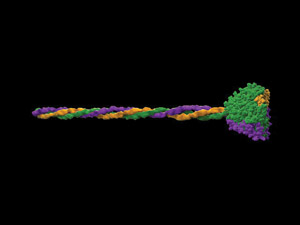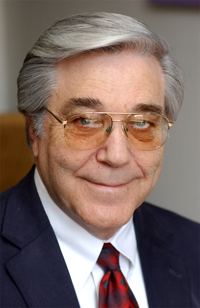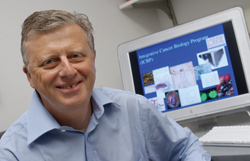
Collagen, illustrated here, is the most plentiful protein in the body and the primary component of the extracellular matrix.
illustration by Symmation LLC
Center’s new Web site helps bring investigators into the ‘matrix’

Billy Hudson, Ph.D.

Vito Quaranta, M.D.
Extracellular matrix, the nebulous goo that fills the space between cells, binds cells together to fashion a functional tissue.
In much the same way, the Center for Matrix Biology at Vanderbilt University Medical Center brings together researchers with seemingly disparate interests to form a cohesive group dedicated to understanding this biological glue. The 38 current CMB members come from at least 10 different departments across the Vanderbilt campus.
“The Center for Matrix Biology is an intellectual center,” said Billy Hudson, Ph.D., Elliot V. Newman Professor of Medicine and director of the Center. “It's not positioned in a building.”
The CMB recently launched a Web site (www.mc.vanderbilt.edu/cmb/) to facilitate communication and interaction among its members and to provide a virtual meeting place for Vanderbilt matrix researchers.
“(The Web site) is a fast way of communicating between researchers, for seeking who has what expertise, knowing what their current interests are, and to quickly send them a message,” Hudson said. Facilitating this communication will aid CMB researchers in formulating important research questions about matrix biology.
“There's no substitute for a good idea. It begins with the question,” Hudson said. “We now have a critical mass of people in matrix biology that are developing those important questions and the technology around us to answer these questions.”
Designer matrix
“The matrix causes cells to multiply and proliferate,” Hudson said. “It gives organization to the tissue, compartmentalizing tissues to influence function as well as mechanical structure. We couldn't even sit here without some mechanical structure to the cell.”
Every cell type lives in its own distinctive matrix microenvironment. The composition of the matrix surrounding neurons, for example, differs from that surrounding liver cells. To be able to efficiently grow and study these cells in the lab (in vitro), the matrix has to be custom-fit to the cells it supports.
“If we know what the components are, how they interact with each other, and what their biological activity is, we can then make a designer matrix with some specific function,” Hudson said. That designer matrix might then be used to aid research, drug development, and the development of medical and research devices.
“The idea of the CMB is to make it possible for people to use the matrix in their experiments in ways that haven't been possible to this point,” said Vito Quaranta, M.D., professor of Cancer Biology and co-director of the Center.
This goal — to develop microfabricated microenvironments for basic research and high-throughput drug discovery — is shared by researchers in the Vanderbilt Institute for Integrative Biosystems Research and Education (VIIBRE).
"The CMB is going to open up a whole new frontier of biology," said John Wikswo, Ph.D., VIIBRE director, and Gordon A. Cain University Professor and professor of Molecular Physiology and Biophysics.
Historically, advances in physiology and biology have been made using animal models and isolated tissue preparations, or cultures of a single type of cell in suspension or attached to the bottom of a fluid-filled dish.
“The CMB will be critical as we move toward developing the frontier between these two extremes — perfused, mixed-cell cultures with a realistic matrix that establishes the physical structure and conveys critical information between cells," Wikswo said.
"I see the CMB working closely with VIIBRE on projects that include the role of the tissue microenvironment in angiogenesis, cancer metastasis and inflammation.”
"Clearly, the CMB is already providing an intellectual matrix, as we all start gluing different people and cells together to move beyond having one kind of scientist looking at only one cell type at a time," Wikswo added.
A better understanding of the matrix will also facilitate the discovery of disease mechanisms and hasten the development of drugs to treat those diseases.
“Matrix has a critical role in normal tissues that are remodeled during adult life,” says Eric G. Neilson, M.D., Hugh Morgan Professor and chair of the Department of Medicine. Production of new matrix is particularly important in wound healing.
But in conditions of chronic inflammation, fibroblasts (the primary cells that make matrix) are stimulated to produce excess amounts of matrix, leading to a process called fibrosis or fibrogenesis. This is seen in the heart, lungs, kidneys and liver in chronic disease.
“Unless fibrosis is attenuated by altering the signaling mechanisms in fibroblasts, the organ cannot survive,” Neilson said. “The biology of fibrogenesis is exploding with new ideas that apply to organ pathophysiology and cancer progression. As these fields of medicine begin to incorporate new thinking about fibrotic matrix into mechanisms of disease, many new therapeutic targets become available. This is an exciting time to be working on these problems,” Neilson said.
Cancer matrix
The role of the matrix in cancer biology is also a major research focus for several CMB members.
As reported in the Oct. 22 issue of the Reporter, Quaranta and colleagues have received a major grant from the National Cancer Institute to study cancer invasion and to develop mathematical models that will help predict tumor progression and metastasis.
The composition of the matrix is one of the key parameters that go into such models. Using computer simulations based on these mathematical models, Quaranta has found that disruptions in the matrix allow tumor cells to invade healthy tissue.
“It is as if tumor cells sense the composition of surrounding matrix and move into it according to rules that we do not fully understand” Quaranta said. “One major goal is to support activities that lead to an understanding of these rules through quantitative measurements of matrix parameters.”
The extracellular matrix and the enzymes that break it down (matrix metalloproteinases, or MMPs) influence the ability of tumor cells to grow in sites distant from their origin, a process called metastasis. In some cases, the normal organ environment can be altered so it dominates the tumor cells and prevents the formation of metastases.
To understand this process Lynn Matrisian, Ph.D., Ingram Professor of Cancer Research and professor and chair of Cancer Biology, and colleagues have been devising “organotypic” models that mimic lung, bone, breast and intestinal tract tissue. In addition, Matrisian is examining the possibility that small molecule inhibitors of MMPs may be used to prevent metastatic tumor cells from growing.
“We are very excited about the CMB because we now have access to some very special reagents, and most importantly, experts that can help us make these complex model systems and understand the results we get,” Matrisian said.
“One unique aspect of our program is that we go from the disease down to the basic biology/biochemistry — all the way from the human down to the atom,” Hudson said.
Once the basic biology of matrix-associated diseases is ascertained, the next step is to identify new drug targets and develop drugs to combat those diseases. Progress is developing rapidly.
Hudson and colleagues have developed a drug, Pyridorin, which protects against the harmful modification of matrix proteins by glucose that occurs in diabetic kidney disease. The drug was recently approved to enter Phase 3 clinical trials to treat diabetic nephropathy (the thickening that occurs in the kidneys of diabetics).
“Clearly the emphasis is on basic mechanisms of disease and biology,” Hudson said. “But we also know that, at Vanderbilt, if we can do something about it, we will.”













